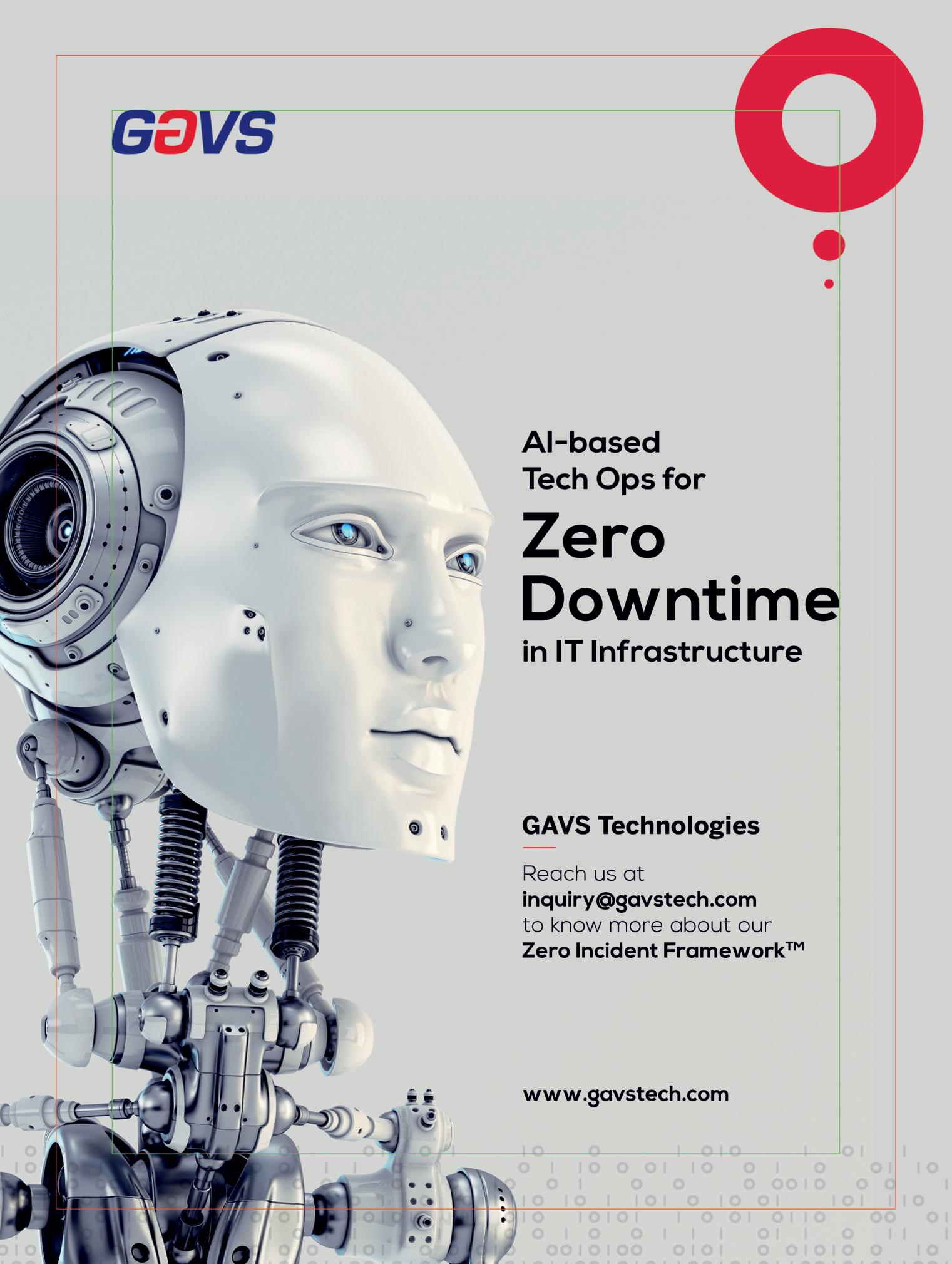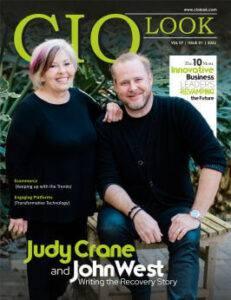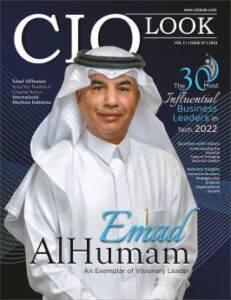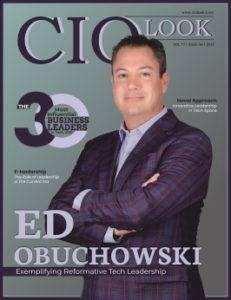
From Strategy to Rollout Transforming Industries with AI Innova�on
From Lab to Market Exploring the Poten�al of Next-Gen AI Technologies
Edwina Fitzmaurice EY Global Innova�on Market Ac�va�on Leader


From Strategy to Rollout Transforming Industries with AI Innova�on
From Lab to Market Exploring the Poten�al of Next-Gen AI Technologies
Edwina Fitzmaurice EY Global Innova�on Market Ac�va�on Leader



Inaneramarkedbyrapidtechnologicalevolution,the
conversationaroundartificialintelligencehasshifted frompossibilitytopractice.Organizationsacross industriesareincreasinglyleveragingAItodrive efficiency,innovation,andcompetitiveadvantage.Yet, amidthistransformation,acriticalquestionarises:how canweensurethatinnovationremainsfundamentally human-centric?Astechnologycontinuestoreshapethe businesslandscape,leaderswhoprioritizeethical, inclusive,andpeople-focusedapproachesaresettingthe standardforresponsibleAIadoption.
CIOLook,initsrecenteditiontitledLeadingInnovation, Together:HowEY’sEdwinaFitzmauriceisShaping Human-AICollaboration,highlightstheworkof EdwinaFitzmaurice,EY’sGlobalChiefCustomer SuccessOfficer.Sheisguidingthestrategicintegrationof AIacrossvarioussectorswhilesimultaneouslyhelpingto redefinetheprinciplesofeffectivehuman-AI collaboration.Emphasizingtrust,ethics,andinclusive

innovation,FitzmauriceadvocatesforavisioninwhichAI servestoenhancehumanpotentialratherthanreplaceit. Herleadershipunderscoresagrowingunderstandingthat thefutureofbusinessdependsnotonlyonthecapabilities ofmachines,butalsoontheabilityofpeopleand technologytoworktogethertoaddresscomplex challenges,inspirecreativity,andcreatelastingvalue.
Asartificialintelligencecontinuestoevolve,itssuccess willdependnotsolelyontechnologicalsophisticationbut onthevaluesthatguideitsimplementation.Leaderslike EdwinaFitzmauricedemonstratethatwheninnovationis groundedintrust,ethics,andcollaboration,itcanamplify humanpotentialanddrivemeaningfulprogress.Thepath forwardliesnotinchoosingbetweenhumansand machines,butindesigningsystemswherebothcontribute uniquelytobuildingamoreinclusiveandintelligent future.
Haveagreatreadahead!

12

16
C O V E R S T O R Y


A R T I C L E S
From Strategy to Rollout
Transforming Industries with AI Innova�on
From Lab to Market Exploring the Poten�al of Next-Gen AI Technologies is Becoming Part of the
C O N T

PoojaMBansal Editor-in-Chief
CONTENT
Deputy Editor Anish Miller
Managing Editor Prince Bolton

FOLLOWUSON WE ARE ALSO AVAILABLE ON
www facebook.com/ciolook/ www.x.com/ciolookmagazine
DESIGN
Visualizer Dave Bates
Art & Design Director Davis Mar�n
Associate Designer Jameson Carl
SALES
Senior Sales Manager Wilson T., Hunter D.
Customer Success Manager Nelson M.
Sales Execu�ves Tim, Smith
TECHNICAL
Technical Head Peter Hayden
Technical Consultant Victor Collins July,
Research Analyst Eric Smith
SEO Execu�ve Alen Spencer
CONTACTUSON
Email info@ciolook com
For Subscrip�on www.ciolookmedia.com
Copyright © 2025 CIOLOOK, All rights reserved. The content and images used in this magazine should not be reproduced or transmi�ed in any form or by any means, electronic, mechanical, photocopying, recording or otherwise, without prior permission from CIOLOOK. Reprint rights remain solely with CIOLOOK.



In the last few years, GenAI has swiftly evolved from
experimentaltechnologyintoacompetitivebusinesstool Now,AIisbecomingacoworker.
The emergence of GenAI prompted an era of AI democratization as publicly available tools like OpenAI’s ChatGPTsparkedmainstreamenthusiasm Manyorganizations approached this initial phase cautiously given complex complianceconcernsandconfusionoverwheretostartandhow tocreatevalueforthebusiness
However, hesitation has transformed as productivity and positive user sentiment has soared. Leading organizations are accelerating adoption as they pivot to integrate AI into operations and workflows, backed by robust governance, dedicatedAIstrategies,andcomprehensivetrainingprograms
This shift alters how employees perceive their roles and how organizations think about productivity, talent and skill development, and competitive growth. As AI evolves into a trustedcomponentofbusinessoperationsalongsidetheriseof AIagentsandembeddedsolutionslikeMicrosoft365Copilot, CIOs must address the cultural and ethical implications of implementingAIasacoremechanismofbusinesssuccess
Initial enterprise GenAI adoption was often fragmented, markedbyprolificshadowAIasunauthorizedemployeeuseof conversational tools such as ChatGPT led to widespread concernsoverdataandIPleakage

ThoughpeoplerecognizedtheefficacyofAIforanalysis,task automation, brainstorming, and drafting, many hesitated over concerns of data exposure, compliance breaches, or possible career repercussions by being irresponsible in the accelerated useofAIoralternativelybybeingperceivedasalaggardfornot movingquicklyenough Leadingorganizationscounteredfear culturebyreframingAIasanempoweringtoolthroughliteracy programs, training initiatives, AI champion communities, learningtodevelopclearguardrails,andvettingtools.
For EY, this evolution meant preparing a 400,000-person workforcetocollaboratewithAIeffectively.“Manyemployees initially experience AI as a digital assistant that enhances productivity,”saysEdwinaFitzmaurice,EYGlobalInnovation MarketActivationLeader “TheanalogyofGenAIasacapable internisbecomingincreasinglycommon,buttheseAIassistants stilldependonhumanjudgmentandsupervisionforaccuracy, context,andresponsibledecision-making.”
EY achieved a strategic milestone with early adoption of Microsoft365Copilot.Asaknowledgeorganizationdependent on tools like Excel, Outlook, and Teams, EY recognized the opportunitytominimizefrictionindailytaskswhilefosteringa morefulfillingworkexperience EYisrollingoutM365Copilot to 150,000 EY professionals globally, about one-third of its workforce,afterpilotingarobustvaluemeasurementandrisk framework. Value was measured across three dimensions, including human sentiment, productivity, and quality, to determinehowM365Copilotcouldbenefitthebusinessand EYpeople.

“CopilothelpsEYteamsorganizetheirday,prioritizeactivities, prepareformeetings,andgetaheadstartonnewprojects,”says Fitzmaurice “It changes how people start and finish their workdays, enabling stronger focus and reducing the typical stressandeffortinvolvedincompletingwork”
GenAIopenedapathwayforautonomousagentsthatactively performtasksinsteadofjustsupportingit.AIagentscanexecute specificworkflowswithminimalhumanintervention,suchas brandcomplianceevaluationsorcustomerserviceinteractions, to substantially improve efficiency, consistency, and personalization
The deployment of M365 Copilot at EY exemplifies this; employeescanuseAIagentstoreadilyleverageaccurate,realtime,data-driveninsightsforapplicationslikegeneratinghighqualityclientproposals.M365Copilot’sabilitytocomprehend queries in multiple languages lowers adoption barriers and allows EY professionals to securely tap into external and internaldatasourcesglobally
Perhapsmostsubstantively,M365Copilotisprovingtobean important tool for disabled and neurodivergent EY professionals. A groundbreaking EY study of over 300 employees across 17 different organizations worldwide who identifyasdisabledand/orneurodivergentindicatesthat91%of respondentsbelieveGenAIisavaluableassistivetechnology, and85%feelitcansupportamoreinclusiveworkenvironment
As neurodiversity rises, with 53% of Generation-Z respondents identifying as neurodivergent today and a projectionthatthiswillincreaseto70%forGenerationAlpha, such impact signifies AI’s potential to enable a more accessible,empoweringorganizationalculture.
IntegrationofAItoolsandagentsintodailyoperationsreshapes expectations around job roles, skill requirements, and leadership priorities. Prompt-engineering, no-code development,AIagentcreation,andresponsibleAIarequickly becomingcorecompetenciesforeveryone.
Forward-thinking professionals that embrace these new opportunitiessituatethemselvesascriticalcontributorstotheir organization’s future At EY, the M365 Copilot experience conveysthatmeaningfulculturaltransformationisn’tasolitary “aha” moment, but rather a collective evolution of behaviors, workflows,andmindsets.
Employees must also understand thatAI’s ability to enhance human capabilities doesn’t mean it can replicate human judgment,ethicalreasoning,orvalues “Weoftenseeeffortsto anthropomorphizeAI,andwehaveseenourpeoplegivehuman namestoAIagents,”explainsFitzmaurice “Superficially,this mayseemharmlessbutitblurstheboundariesbetweentooland teammate Leadershipteamsshouldreinforcethemessagethat AIisapowerfultoolrequiringguardrailsandcontrols,nota sentient colleague, to promote responsible AI education acrosstheorganization.”
In this emerging era of AI coworkers, human empowerment mustbeforemostasevolvingworkforcestrategieschangehow organizationsoperate,compete,andadvance.Someemployees continuetoregardAIasajobthreatbutemphasizingaculture where embracing AI and the learning provided encourages confidence with emerging AI technologies and enhances careers
As CIOs look ahead, AI agents and tools like M365 Copilot representaninflectionpointinthewaywework.Organizations thatrespondtothisevolutionbymobilizingtheirworkforceto collaborate harmoniously alongside AI, adopting a mindset whereAI assistants andAI agents become part of the natural workflow,willhelpcreateanenvironmentwherepeoplearen’t competing with this technology, but growing their careers alongsideit





From Strategy to Rollout


Artificial Intelligence (AI) has transformed industries,
turning business models upside down, construction processes,andopeningupfreshrealmsforinnovation possibility Across healthcare to finance, manufacturing to retail, businesses are turning to AI to make decisions, drive productivity, and deliver differentiated customer experience
Thehigherthetechnology,thelargeristhedisruptionbrought about by it in industries, increasing growth, competitiveness, and long-term sustained growth.AI convergence is not just a technology revolution, but a problem-solving, customer engagement, and value creation design revolution. With evolving machine learning, natural language processing, computervision,androbotics,AIcannolongerbeputonthe periphery Itisanactual,scalable,andedgesolutionthatenables organizations to react to emergent issues and grow with changingmarketforces.
Thehealthcarefieldhaswitnessedsomeofthemostinnovative applications ofAI, promoting clinical expertise in addition to operationalefficiency AItechnologyisspeedingupdiagnosis by reviewing medical images, patient data, and pathology reportsfasterandmoreeffectivelythanthroughthetraditional method. For example, deep learning techniques can diagnose radiologicimagepathologywhenappliedtoenabledoctorsto performpreliminarydiseasediagnosessuchascancer,stroke, and cardiovascular disease. Further, AI decision support systems help doctors prescribe personalized treatment regimens based on real-time data, genomic data, and clinical guidelines
Operatively,AIismakinghealthcareandresourcemanagement logical. Predictive analytics can forecast patient admissions, automatestaffdeployment,andcontrolstocklevelstomakethe running of a hospital cost-efficient Conversational health
assistantsthatutilizeAIalsolightentheworkloadofdoctorsby responding to basic questions, scheduling appointments, and reminding patients to take medication Not only do they improvethepatientexperienceintermsofquality,butexpenses areloweredandoverallcarequalityimproved
Artificial intelligence is as much changing the banking and finance industry as it is changing the economy. It is revolutionizingprocessautomation,riskprevention,andhighly customized customer experience Banks and financial institutions use AI algorithms to assess credit risk, identify suspicious transactions, and meet regulatory requirements Machine learning algorithms scan billions of bytes of transaction data and cross-matching them to identify uncommonpatternsandhenceenableinstantfraudprevention anddetection.Otherthanthat,AIimprovescreditscoringbythe abilitytoincorporatenon-traditionalsourcesofinformationand thereforeofferingfinancialproductstotheunderbanked AIin wealth management and investment is revolutionizing businesses with algorithmic trading platforms and predictive analytics faster to respond to market signals than a human trader.
Natural language processing (NLP) is also being applied to searching for earnings announcements, social mood, and financial news to inform investment decisions Chatbots and robo-advisorspoweredbyAIarealsoofferingcustomers24/7 customer service and personalized financial advice, with high userengagementandsatisfactionlevels.Alltheseservicesare demonstrating the potential of AI to boost transparency, minimizerisk,andmakebetterfinancialchoices.
AI technology is revolutionizing the supply chain and manufacturing Factory AI technology tracks equipment performance, predicts maintenance needs, and regulates
production operations. Using IoT deployment of sensors and machinelearning,businessescandetectequipmentanomalies prior to equipment failure, reduce downtime, and increase productivity AI-drivenrobotsarealsorevolutionizingfactory processes to become more accurate and faster, with mass customizationwithoutcompromisingonquality
Supplychainmanagementthathadbeenpreviouslyreactivein itsprocessesisgoingdata-drivenandproactiveasAIarriveson the scene. Predictive analytics and demand planning allow firms to make better forecasts on market drivers, stabilize inventory, and minimize disruption. For instance, during periods of global pandemics or world war, AI can forecast accordingtoreal-timedataandrecommendalternativesourcing basesandalternativetransportmodes Withsustainabilitybeing the priority,AI is also assisting companies in tracking carbon footprints,reducingwaste,andoptimizingenergyuseacrossthe supplybase.
No longer science fiction story of tomorrow's day AI is a change driver in the making today reshaping business From improving the accuracy of medicine diagnosis to perfecting money-making choices and retooling supply chain management,AIisyieldingmeasurableincreasesinefficiency, innovation,andcustomersatisfaction Itscapacityforhandling volumes of data, automating processes, and generating actionableintelligenceisempoweringbusinessestocompetein anincreasinglydynamicglobaleconomy Thefullpotentialof AIcanonlybeunleashedwithovertechnologydeployment.It requirescommitmenttoethicalutilization,continuouslearning, and considered usage consistent with business objectives. In developingthecultureofinnovationandresponsibility,notjust canindustriesembraceAItodrivesolutionsinthiserabutalso laythefoundationsforsustainableandinclusivedevelopment inthefuture Sincemoreresearchworkisbeingdoneinthisera ofAI,vision-basedandobjective-drivenleaderswillbethereal creatorsofindustrialrevolution.






ArtificialIntelligence(AI)hasmadesignificantstrides
over the past decade, transforming industries and reshaping the way we live, work, and interact. From personal assistants to predictive analytics, AI has become deeplyembeddedinmodernlife.However,thenextgeneration of AI technologies promises capabilities that go far beyond today’sapplications Theseadvancementsofferthepotentialto unlock new efficiencies, enable deeper understanding, and create tools that were once confined to the realm of science fiction As organizations prepare to navigate an increasingly data-driven and automated future, understanding the capabilities and implications of next-genAI is critical. These systems, powered by advanced algorithms, multimodal learning, and scalable infrastructure, are not only more intelligentbutalsomoreadaptable Theyrepresentaparadigm shift from task-specific models to general-purpose systems capableofreasoning,learning,andcollaboratingindynamic environments.
Oneofthedefiningfeaturesofnext-genAItechnologiesistheir ability to process and interpret multiple forms of input, includingtext,images,audio,andvideo,simultaneously These multimodal systems represent a significant leap from earlier modelsthatweretypicallyrestrictedtoasingledatatype With modelslikeOpenAI'sGPT-4oandothers,AIsystemscannow switchbetweenmodalitiesorintegratethemtogeneratemore context-aware, nuanced responses. This breakthrough paves thewayformoreholistichuman-computerinteractionandmore robust real-world applications, such as autonomous systems, diagnosticsinhealthcare,andadaptiveeducationplatforms
Additionally, next-gen AI is increasingly being designed as general-purposetechnology.UnlikenarrowAI,whichistrained for specific tasks, general-purposeAI systems can perform a wide range of functions without requiring task-specific


retraining.Thisshiftismadepossiblebyinnovationsintransfer learning, reinforcement learning, and large-scale neural architectures Asthesemodelsbecomemoregeneralizableand capable of self-directed learning, they promise to reduce the need for costly, time-intensive development cycles, making advancedAImoreaccessibleandscalableacrossindustries
Next-gen AI technologies are set to drive significant transformationsacrossawiderangeofindustries Inhealthcare, AIisbeingusedtoaugmentdiagnostics,personalizetreatment plans,andanalyzecomplexmedicaldatawithimpressivespeed andaccuracy Forinstance,AI-drivenradiologytoolscandetect abnormalities in imaging scans more efficiently than human practitioners in certain contexts. In the pharmaceutical sector, AIisacceleratingdrugdiscoverybymodelinghowcompounds interactatthemolecularlevel,dramaticallyreducingthetime requiredforresearchandtesting
In finance, advanced AI models are improving risk analysis, enhancing fraud detection systems, and refining algorithmic trading strategies These systems can analyze vast datasets in realtime,identifyingtrendsandanomaliesthathumananalysts might overlook. In manufacturing and logistics, AI supports predictivemaintenance,computervision-basedqualitycontrol, andreal-timesupplychainoptimization Othersectors,suchas retail, agriculture, energy, and education, are also being reshapedasAIhelpsbusinessesstreamlineoperations,reduce costs, and create new value The cross-sector impact of these technologieshighlightstheirroleasenablersofinnovationand enginesoflong-termeconomicgrowth.
Despite the enormous promise of next-gen AI, these technologiesraisecriticalethical,legal,andsocietalquestions Issueslikedataprivacy,algorithmicbias,misinformation,and workforcedisplacementmustbeaddressedthoughtfully.AsAI systems become more autonomous and complex, ensuring transparency and accountability becomes increasingly
challenging. For example, large language models and generative AI tools can produce persuasive but inaccurate content, making it difficult for users to distinguish truth from fiction Without appropriate oversight and safeguards, these riskscouldunderminetrustandstallprogress
To navigate these concerns, developers, policymakers, and organizations must collaborate to ensure responsible AI development and deployment. This includes establishing ethical frameworks, promoting transparency, and investing in tools that allow for explainability and system audits It also requires diverse participation across disciplines, ensuring that thevoicesofethicists,technologists,legalexperts,andaffected communities are included in decision-making processes. Internationalcooperationisessentialaswell,particularlysince AI technologies cross borders and jurisdictions. Recent regulatory efforts, such as the European Union’s AI Act, represent an important step toward creating clear and enforceable guidelines for high-risk AI applications Ultimately,thefocusshouldremainonharnessingAI’spower whileprotectingpublicwelfareandensuringequitableaccessto itsbenefits.
Thepotentialofnext-generationAItechnologiesisbroadand transformative Asthesesystemsevolvefromspecializedtools intoadaptableandintelligentplatforms,theyaresettoredefine the limits of what machines can achieve With multimodal capabilities, greater adaptability, and more efficient learning processes,next-genAIispoisedtodeliverinnovationsthatwill touch nearly every aspect of daily life and global industry. However, this progress must be met with a commitment to responsibleuseandethicalgovernance.ThefutureofAIisnot only about smarter systems but also about fostering collaboration between humans and machines in ways that enhance creativity, equity, and problem-solving By staying informed,prioritizingethicalstandards,andencouragingcrosssector partnerships, we can ensure that the next wave of AI advancementsleadstoafuturethatbenefitseveryone.





































































